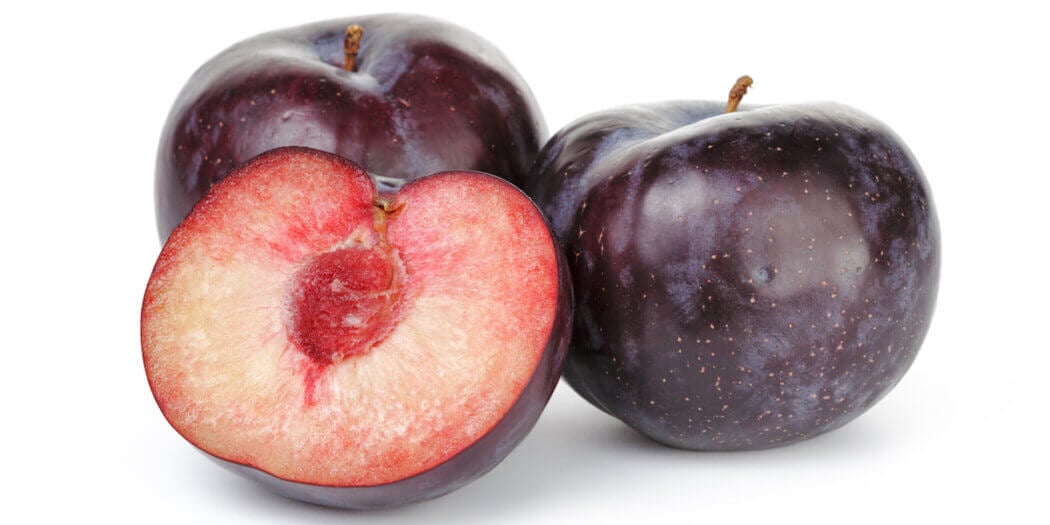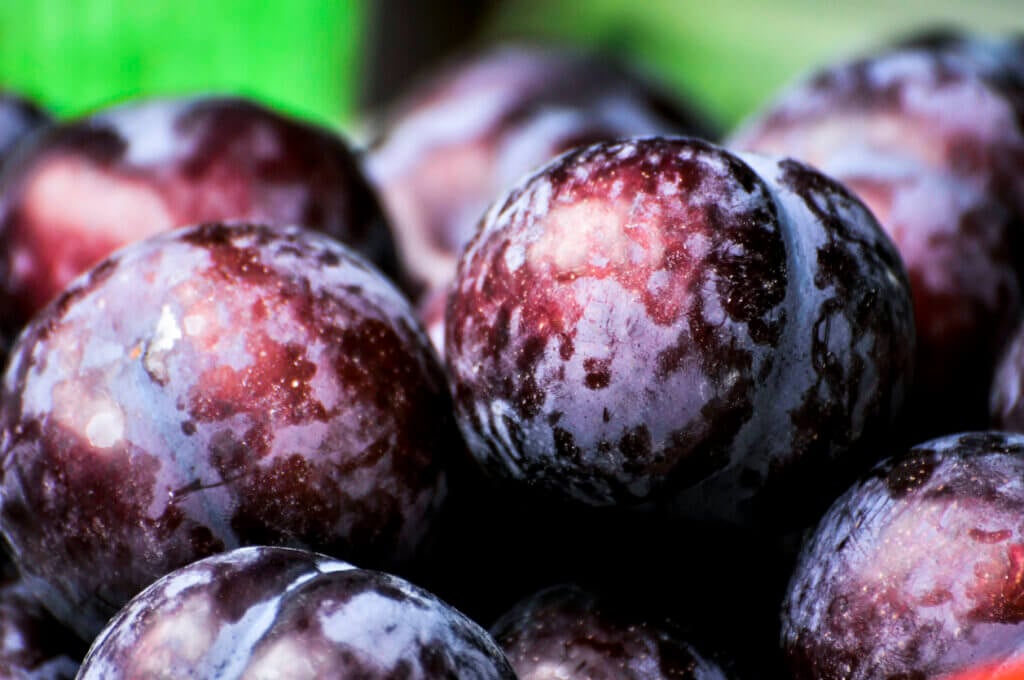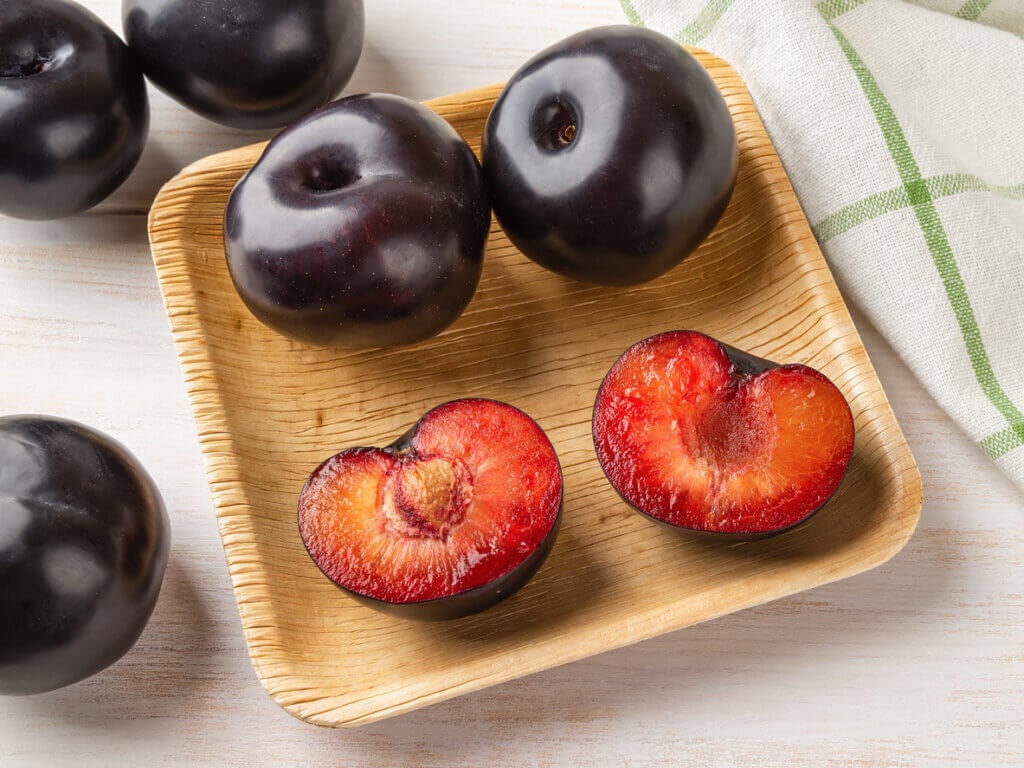Grocery Guides
Plums: Definition, Seasonality, Nutrition, and Storage Tips

What are plums?
A plum is an oval, fleshy fruit with thin, edible skin. Depending on the variety, plums are purple, deep red, red, or yellow when ripe. Plums are classified as stone fruit, or drupes, along with peaches, nectarines, cherries, and apricots. They contain a flattish, pointed pip called a stone.
Where did plums originate from?
There are about three hundred varieties of plums grown and sold in the United States. There are two main types of commercially grown plums. European plums (prunus domestica) originate from Europe and Southwest Asia, and Japanese plums (prunus salicina) originate from China. The European varieties tend to have dense flesh, thicker skin, and higher sugar content. This makes them suitable for drying, baking, and jam-making. Most European plums are oval-shaped and have yellow flesh, but their skins vary in color. Shop organic yellow plums.
Japanese plums are generally larger, juicier, and have softer flesh. They are predominantly bred for eating fresh. Most are round in shape and have thin skins. The color of their skin, as well as that of their flesh, can vary from yellow through red to dark purple. Shop empress plums.
Stone fruit is also classified according to how easily their flesh separates from the pip. Most Japanese varieties are clingstones. This means that flesh clings to the pip and is difficult to separate. The flesh of freestone fruit pulls away from the seed with ease. Most European plum varieties are freestone.

What are the benefits of eating plums?
Plums contain several vitamins and minerals and are a good source of fiber. Here are a few more reasons to put plums into your shopping cart:
- Plums are a good source of Vitamin C.
- They contain a lot of sorbitol, which is a sugar alcohol that acts as a laxative.
- Potassium can also be found in plums.
- Plums have plenty of fiber.
- Plums are also a great source of antioxidants.
How are plums grown?
Plums grow on deciduous trees that blossom in spring before their new leaves emerge. Plum trees usually grow to a height of sixteen feet (five meters). Plums are typically grown in temperate regions. If the weather is too dry, the fruit will not develop properly. If the environment is too wet, the plums will develop a fungus known as brown rot.
When are plums in season?
Most stone fruits do not ripen after they have been picked. They are usually picked at their peak and kept for only a short while after being harvested. They are therefore highly seasonal. Plums are a summer fruit. Plum season in the United States is generally from June to September. The majority of the country’s plums are grown in California. Here you may be able to buy plums from May through to October.
How do you choose plums at the grocery store?
Select plums that have smooth skin that is free of blemishes. Plums should be firm and feel heavy for their size. At optimal ripeness, the flowering end (opposite the stem’s end) should give a little when pressed. Plums destined for sale in a grocery store are shipped while they are still hard and unripe. Ripen them at home by placing them in a brown paper bag for a day or two.
Grab it now on Instacart:
How to store plums
Store unripe plums in a loosely closed brown paper bag at room temperature for a few days until they are ripe. If you have bought a lot of plums and want to stagger their ripening, you can store some of them on the counter and the remaining plums in the refrigerator. Once ripe, plums should be consumed within a day or two. They will keep a little longer if stored in the fridge.

How to freeze plums
If you have a glut of plums, you may want to store some in the freezer for later use in smoothies or making ice cream. Here is how to freeze plums:
- Thoroughly wash your plums and dry them.
- Cut them in half and remove the pip.
- Lay the plum halves on a baking tray and place them in the freezer for a few hours.
- Once the plums are frozen, place them in freezer bags. Remove as much air from the bags as possible and seal them.
- Store frozen plums in the freezer for up to six months.
How to tell when plums are bad
Plums that are turning bad will become very soft and get dark spots. Their skin may have a wrinkly appearance, and the fruit may start to ooze. Discard any plums that are moldy or have a fermenting smell.
What can I substitute for plums?
In recipes for baked dishes, you could substitute other stone fruit for plums—for example, apricots, peaches, or nectarines. Shop red apricots. In mid-winter, when there aren’t any fresh stone fruit to be had, use dried stone fruit such as prunes or dried cherries.
Shopping for plums
Stock up on the tasty goodness that fresh plums have to offer. Instacart is the ideal convenience for online grocery shopping. Order your fresh fruit from local or international retailers near you. After adding a product to your cart, use the “Instructions” option to notify your Instacart shopper about your preferences or specific directions on how to select the best plums. Choose between having your order delivered to your door or pick-up within two hours.
Most Recent in Grocery Guides

Grocery Guides
15 Tasty Ice Cream Alternatives: Yogurt, Shaved Ice & More
Ice cream has been a beloved treat for generations. With its rich flavors and smooth texture, it’s no wonder people choose ice cream when looking for dessert. However, as dietary restrictions and health consciousness evolve,…...
Apr 10, 2024![When Is Artichoke Season? [Recipes + Guide]](https://www.instacart.com/company/wp-content/uploads/2024/03/when-is-artichoke-season-hero-447x224.webp)
Grocery Guides
When Is Artichoke Season? [Recipes + Guide]
Quick Answer When is artichoke season? In North America, artichoke season is from March to May, with smaller batches in October. Artichokes are a unique and versatile vegetable known for its tender heart and delicate…...
Mar 6, 2024
Grocery Guides
Brown Eggs vs. White Eggs: How Are They Different?
Eggs are an essential ingredient in many sweet and savory recipes. The possibilities are endless when it comes to using these protein-packed powerhouses — you can scramble, fry, boil or poach eggs, or you can…...
Feb 24, 2024







 Squash – All You Need to Know | Instacart Guide to Fresh Produce
Squash – All You Need to Know | Instacart Guide to Fresh Produce  Ghost Pepper – All You Need to Know | Instacart Guide to Fresh Produce
Ghost Pepper – All You Need to Know | Instacart Guide to Fresh Produce  Sprouts – All You Need to Know | Instacart Guide to Fresh Produce
Sprouts – All You Need to Know | Instacart Guide to Fresh Produce 

